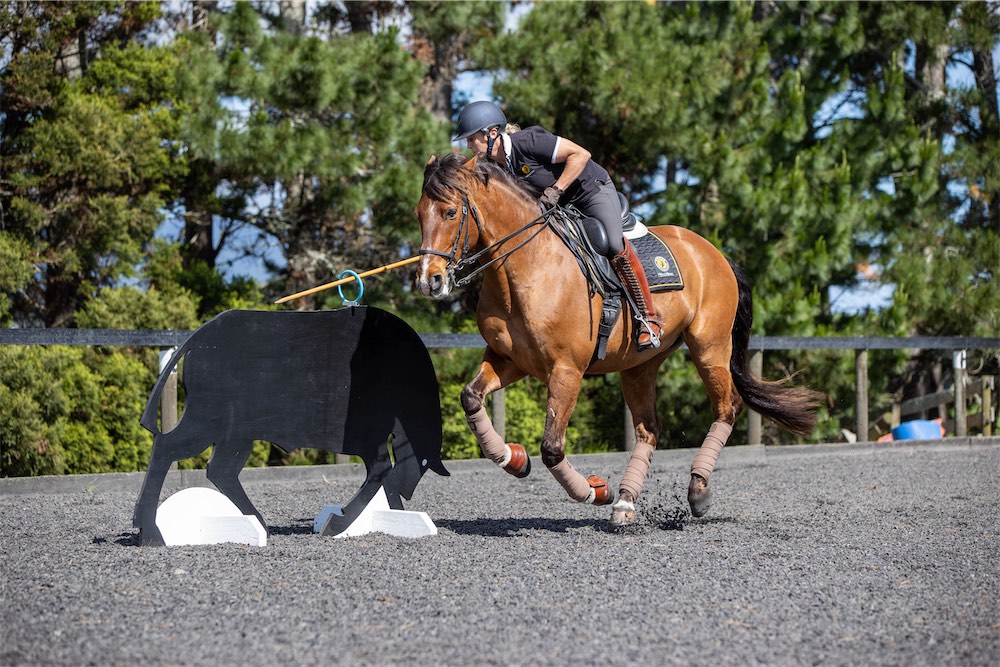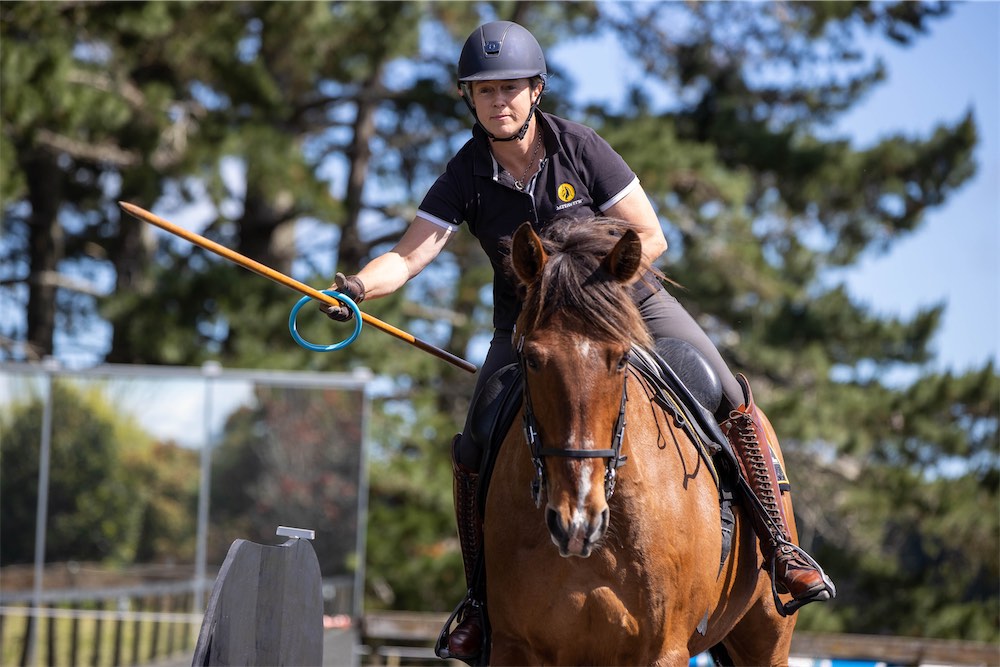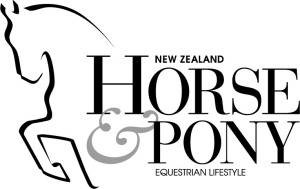
You won’t find too many dressage riders flying around with the reins in one hand and a spear in the other on their Grand Prix horse. But Raglan trainer Jody Hartstone has discovered the multi-disciplinary sport of Working Equitation is not only exciting and a heap of fun, but also has many benefits for horse and rider, whatever their size, shape or ability. Jody is heavily involved in promoting this growing sport in New Zealand and regularly takes clinics around the country. One of her goals is to compete in Working Equitation at Masters level (the highest) with her Lusitano Grand Prix dressage horse, Ali Baba.
Jody first encountered Working Equitation about 10 years ago, when she travelled to Spain and Portugal in search of a dressage horse. With her background in mounted games, Jody quickly realised the sport incorporated the same elements of speed and obstacles, but with an added touch of sophistication.
To the untrained eye, Working Equitation may appear similar to Cowboy Challenge, but there are in fact some major differences. For starters, Working Equitation obstacles must look natural and resemble something you might encounter on a working ranch – you won’t find any pool noodles or tarpaulins. In contrast to Western riding, the horse is ridden up to the bridle, or ‘on the bit’. The sport has its roots in classical dressage and horses are judged on their confidence, balance, rhythm and fluidity as they navigate the obstacles.
Just like dressage, it’s all about harmony between horse and rider, with an emphasis on progressive and ethical training.
“The horse must be relaxed and attentive. At the higher levels, you need a very collected horse in order to do it,” says Jody. “It’s a little bit like a Grand Prix test in that it should be performed with flair and it’s hard to make every obstacle look easy, although that is the goal. For example, Ali Baba is very good at collection and the flying changes, but being patient and immobile in the halt is not really his highlight. To get a horse who is good at every part takes a lot of training.
“Working Equitation is great cross-training and it can also give you some really good goals. When you watch the top riders it really is something to aspire to and there’s almost a clearer pathway to get there than in dressage. You can practise away at home and train a $500 horse to be very good, which is not as easy to do in dressage.”

What is Working Equitation?
Working Equitation is a relatively new hybrid discipline, which originated in Spain, Italy, Portugal and France, although it quickly expanded into Germany, Sweden, the UK and Brazil and is now growing in popularity around the world. “At its core, it combines the equitation practices of a variety of cultures, with the goal of promoting the different techniques of using the working horse for agricultural purposes. It’s as much about keeping the traditions and costumes alive as a skill in itself,” says Jody.
In New Zealand, the sport follows the Working Equitation Down Under rulebook, although a New Zealand version is being developed. Levels start at Intro and work progressively through Preparatory, Preliminary, Novice, Elementary, Medium, Advanced and Masters; there may sometimes also be a lead-rein class. At the lower levels, obstacles are performed at walk or trot, but by Prelim and Novice, canter is introduced. At the highest levels, all obstacles are performed in canter, with flying lead changes, and the rider must hold the reins in one hand only.
There are four disciplines at a competition: a ‘working dressage’ test, ease of handling (obstacles done on style), a speed test over the obstacles and finally a cattle penning test, although the latter is only done in international competitions. Points are awarded for a rider’s placing in each phase, with the points added together to determine the final result, rather than a percentage-based system.
Working dressage differs from ordinary dressage in that the 20m x 40m arena is usually marked out by hay bales or poles on the ground, instead of white pipes. In European countries, riders compete in their country’s traditional dress, but in New Zealand, riders are free to choose. However, everything must match, so if you ride in Western tack, you will be expected to wear Western clothing. One of the lovely aspects of Working Equitation is its inclusiveness – you’ll find one rider in dressage attire, another in full Western costume, and all manner of horse breeds competing against each other.
As for the dressage test itself, horses aren’t judged on the inherent quality of their paces, but on their training, suppleness, work ethic and lightness. The tests are also designed quite differently from a standard dressage test, explains Jody.
“The tests are set up to prepare you for the obstacles and they are more likely to replicate what you would do around cattle, or out on the farm. For instance, in one of the tests, you do an extended canter 20m circle into a medium canter 15m circle into a collected canter 10m circle, all at A. Reinback and leg-yielding comes in at an earlier stage, and there is a lot of leg-yielding in walk, as it’s all about getting the horse more supple.”
If you want to see what Working Equitation looks like when it’s done really well, check out YouTube clips of Pedro Torres and his Lusitano stallion Oxidado performing obstacles at speed. The Portuguese rider is a many-times World and European champion and is simply incredible to watch. Jody has met the famous Oxidado and was also lucky enough to have a lesson with Pedro Torres on a top equitation horse when she was in Portugal.
Who does it suit?

Absolutely everyone – it doesn’t matter if your horse is big, little, hairy or spotted. The national organisation Working Equitation New Zealand promotes the sport as inclusive for riders of all levels and their main goals are encouraging good sportsmanship and ethical training methods.
“There will be a level for you and a great environment to train your horse. There are a lot of horses and people doing Working Equitation who would never turn up to a dressage show, because they just wouldn’t fit in,” says Jody.
“One awesome thing about Working Equitation is that a low level rider might do the best gate and everyone will applaud. That just doesn’t happen in dressage – have you ever seen people clap for someone’s 20m circle in a Prelim dressage test? I love the camaraderie of it.
“It’s all about training your horse and being a lovely rider. For instance, if your horse suddenly stopped to pee in the middle of your round, you would just give it a stroke on the neck and wait for it to finish – you wouldn’t have to worry bout losing marks. We’re trying to train people to have good etiquette and good horsemanship skills as well.”
Jody has riders from all sorts of backgrounds turn up to her clinics, including hunters, trekkers, jumpers, pony club kids, adults returning to riding and Western riders too. “There are quite a lot of dressage riders getting excited about trying Working Equitation, because they want to get out of the arena and test themselves a bit. It also helps their horses get more balanced and collected.”
The Lusitano is the breed traditionally used for Working Equitation and at the highest levels, these are the horses you will typically see. “It really is their sport, because it’s everything they are good at – they are brave, athletic, flexible, intelligent and they really want to work,” says Jody. “It is a sport that has its roots in classical dressage and the horses are that Baroque type. Because you need to be able to ride one-handed, the horses have to be light and easy to manoeuvre around.”
However, at the lower levels, it really doesn’t matter what breed you are on. Jody also stresses that you don’t need any fancy equipment to practise at home. “You can use upturned buckets, road cones, mounting blocks, pot plants or small children if they will stand still enough! People get really inventive.”

How can Working Equitation improve your horse?
How can Working Equitation improve your horse?
Working Equitation is a great cross-training skill that will not ruin any of your dressage training. In fact, the obstacles can really help, says Jody. “If you’ve got a horse that is hard to collect in canter, for instance, and you start working it around the barrels and through the slalom, gradually progressing your exercises, you can really teach them to collect and get their flying changes better. The obstacles help the horse to bend and be flexible, rather than drilling the horse with straight lines and circles in the arena.”
Working Equitation gives the horse purpose in their work and will make them more well-rounded and braver; once they learn not to be scared of the bull, they’re not going to be scared of signs on the side of the dressage arena! “If you always ride at home and your dressage is just a clear, blank space, it’s not preparing your horse for things like Horse of the Year, where there is just so much more happening. Training your horse to be used to all these different obstacles and maneuvering them around them is a really good thing. It teaches them to be more bomb-proof.”
Riding one-handed is also a wonderful goal to strive for and can help sort out contact issues and improve your balance as a rider, says Jody.
“Working Equitation keeps you both fresh and improves the bond between you and your horse because you’re doing some pretty cool stuff together.”

How do I get started?
Find a local club in your area (these are listed on the Working Equitation New Zealand website). Most clubs have training days and practice days, or look out for a clinic.
- this article was first published in the January 2022 issue of NZ Horse & Pony








